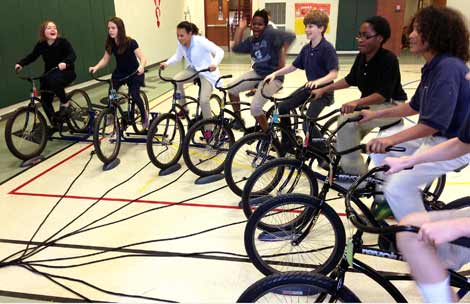INDIANAPOLIS — On the first day of a new program at his school, a sixth-grade boy gets situated in the saddle of a stationary bicycle and says aloud to himself, smiling: “I’ve never ridden a bike before.”
He slowly pushes the pedals, first with his right foot, then his left, and seconds later he’s doing it. He’s finally riding a bike. He and his classmates have quickly started to test their speed, well before the visiting coach has started the simulated bike course on the TV in front of them.
In the bleachers next to the bike setup, Kim Borges is also smiling as she watches the kids get into the exercise. She works for Regions Bank, which brought this bike program into the school, and she’s excited to see Day One of an educational partnership that’s been months in the making.
Very few states require financial education in schools, leaving young Americans without the knowledge of basic financial concepts they need as adults, like budgeting, using bank accounts and saving. The solution? Bring in bikes.
At least, that’s how Regions is approaching the issue.
The Indianapolis division of Regions Bank partnered with Nine13sports, a local nonprofit that promotes youth health and wellness through bicycling programs, to bring financial education into two Indianapolis Public Schools.
Here’s how the idea works: The bikes are fun and encourage physical activity, and the program through Regions teaches real-world financial skills in the classroom. What’s more fun: A bank that teaches you about budgets, or a bank that teaches you about budgets AND brings bikes to your school during gym class?
“It’s physical fitness, but it’s financial fitness, too,” said Borges, the area marketing manager for Regions in Indiana and Illinois. “So if you can offer both, how great is that?”

Sixth-grade students at Rousseau McClellan School #91 test their cycling skills on a digital bike course during an April physical education class.
Filling Gaps in Education
The Regions-Nine13 partnership started at one middle school and one high school in the IPS system during April, national financial literacy month. Nine13 brings its “Kids Riding Bikes” program to the schools during physical education classes once a week for five weeks, and after those five weeks, Regions volunteers go to classrooms to teach some money-handling skills. The fourth-, fifth- and sixth-graders at Rousseau McClellan School #91 will learn about understanding wants versus needs and budgeting basics, and the ninth graders at Gambold Preparatory High School will get more into the details of saving and planning for college. Students at Gambold Prep will also use the bicycling data in their math and science lessons about time, distance, speed and statistics.
As far as understanding money basics, Indiana has room for improvement. A recent WalletHub report puts Indiana at No. 25 on a list ranking states and the District of Columbia by financial literacy. The rankings weighed various metrics, including information from the Internal Revenue Service, Champlain University’s High School Financial Literacy Grades, the U.S. Census Bureau and the percentage of residents with an emergency fund.
Indiana got a C on the High School Financial Literacy Grades, because it doesn’t require students to take personal finance courses or assessments (only 20 states do). The state requires personal finance electives to be offered and topics to be taught in related courses, but the students don’t need to enroll in those classes.
Hoosiers seem particularly challenged by saving: Only 33% of Indiana residents have saved up for a rainy day, according to the WalletHub report. That puts the state at No. 49 — it’s a three-way tie for last place with New Mexico and Mississippi.
The “Kids Riding Bikes powered by Regions” program is an effort to make sure the next generation gets the foundation they need to financially succeed as adults.
“We’re always looking for things that are going to make things fun for the students,” said Margaret Higgs, principal of Rousseau McClellan. “Our goal is not to just teach them facts and figures but to teach them how to think and how to conceptualize what it is they need to do, and one of the things that’s really important in life is that you understand money, understand finance.”
Making Finance Fun
Bicycles brought Nine13 and Regions together — Nine13 has conducted fitness programs for Central Indiana youth for 2 1/2 years, and one of Regions’ logos is a bright green bicycle. Both organizations wanted to find a way to unite over their shared symbol.
They decided to test the idea out in schools, combining two important missions — better health and financial understanding — in one cool program, said Tom Hanley, executive director of Nine13sports. Hanley said he hopes the partnership will expand to other schools in the fall.
“I wish we would have had this — basic budgeting and saving skills would have been so helpful,” Borges said, reflecting on her early education years. Watching the Rousseau McClellan sixth-graders furiously pump their legs on the bikes (which are made stationary), she laughed and added: “I wish we had this, too.”
The students will connect with bankers through Regions’ “Scholars & Dollars” program, where they’ll learn financial fundamentals, money management and practices like check writing. The lessons culminate in a project that simulates running a business or balancing household finances, so students can see the real-life implications of the things they’ve learned.
The idea is to keep it simple but memorable, so children and teenagers can approach adulthood better prepared for the daily demands of personal finance.
For Borges, it all goes back to the bicycle:
“Banking can be so complicated sometimes, but it really should be as simple as riding a bike.”
More Money-Saving Reads:
- How to Get Your Free Annual Credit Report
- What’s a Bad Credit Score?
- How Credit Impacts Your Day-to-Day Life
Main image: monticelllo; inset image: Christine DiGangi
You Might Also Like
September 13, 2021
Uncategorized
August 4, 2021
Uncategorized
January 28, 2021
Uncategorized





